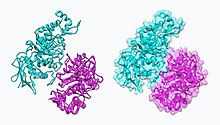Beta-hexosaminidase
| β-N-acetylhexosaminidase | |||||||||
|---|---|---|---|---|---|---|---|---|---|

Hexosaminidase A (Hex A)
|
|||||||||
| Identifiers | |||||||||
| EC number | 3.2.1.52 | ||||||||
| CAS number | 9012-33-3 | ||||||||
| Databases | |||||||||
| IntEnz | IntEnz view | ||||||||
| BRENDA | BRENDA entry | ||||||||
| ExPASy | NiceZyme view | ||||||||
| KEGG | KEGG entry | ||||||||
| MetaCyc | metabolic pathway | ||||||||
| PRIAM | profile | ||||||||
| PDB structures | RCSB PDB PDBe PDBsum | ||||||||
| Gene Ontology | AmiGO / QuickGO | ||||||||
|
|||||||||
| Search | |
|---|---|
| PMC | articles |
| PubMed | articles |
| NCBI | proteins |
| β-hexosaminidase subunit alpha | |
|---|---|
| Identifiers | |
| Symbol | HEXA |
| Entrez | 3073 |
| HUGO | 4878 |
| OMIM | 606869 |
| RefSeq | NM_000520 |
| UniProt | P06865 |
| Other data | |
| EC number | 3.2.1.52 |
| Locus | Chr. 15 q24.1 |
| β-hexosaminidase subunit beta | |
|---|---|
| Identifiers | |
| Symbol | HEXB |
| Entrez | 3074 |
| HUGO | 4879 |
| OMIM | 606873 |
| RefSeq | NM_000521 |
| UniProt | P07686 |
| Other data | |
| EC number | 3.2.1.52 |
| Locus | Chr. 5 q13.3 |
| hexosaminidase C | |
|---|---|
| Identifiers | |
| Symbol | MGEA5 |
| Entrez | 10724 |
| HUGO | 7056 |
| OMIM | 604039 |
| RefSeq | NM_012215 |
| UniProt | O60502 |
| Other data | |
| EC number | 3.2.1.52 |
| Locus | Chr. 10 q24.1-24.3 |
| hexosaminidase D | |
|---|---|
| Identifiers | |
| Symbol | HEXDC |
| Alt. symbols | FLJ23825 |
| Entrez | 284004 |
| HUGO | 26307 |
| RefSeq | NM_173620 |
| UniProt | Q8IYN4 |
| Other data | |
| EC number | 3.2.1.52 |
| Locus | Chr. 17 q25.3 |
Hexosaminidase (EC 3.2.1.52, beta-acetylaminodeoxyhexosidase, N-acetyl-beta-D-hexosaminidase, N-acetyl-beta-hexosaminidase, N-acetyl hexosaminidase, beta-hexosaminidase, beta-acetylhexosaminidinase, beta-D-N-acetylhexosaminidase, beta-N-acetyl-D-hexosaminidase, beta-N-acetylglucosaminidase, hexosaminidase A, N-acetylhexosaminidase, beta-D-hexosaminidase) is an enzyme involved in the hydrolysis of terminal N-acetyl-D-hexosamine residues in N-acetyl-β-D-hexosaminides.
Functional lysosomal β-hexosaminidase enzymes are dimeric in structure. Three isozymes are produced through the combination of α and β subunits to form any one of three active dimers:
The α and β subunits are encoded by separate genes, HEXA and HEXB respectively. Beta-hexosaminidase and the cofactor GM2 activator protein catalyze the degradation of the GM2gangliosides and other molecules containing terminal N-acetyl hexosamines. Gene mutations in HEXB often result in Sandhoff disease; whereas, mutations in HEXA decrease the hydrolysis of GM2 gangliosides, which is the main cause of Tay-Sachs disease.
Even though the alpha and beta subunits of lysosomal hexosaminidase can both cleave GalNAc residues, only the alpha subunit is able to hydrolyze GM2 gangliosides because of a key residue, Arg-424, and a loop structure that forms from the amino acid sequence in the alpha subunit. The loop in the alpha subunit, consisting of Gly-280, Ser-281, Glu-282, and Pro-283 which is absent in the beta subunit, serves as an ideal structure for the binding of the GM2 activator protein (GM2AP), and arginine is essential for binding the N-acetyl-neuraminic acid residue of GM2 gangliosides. The GM2 activator protein transports GM2 gangliosides and presents the lipids to hexosaminidase, so a functional hexosaminidase enzyme is able to hydrolyze GM2 gangliosides into GM3 gangliosides by removing the N-acetylgalactosamine (GalNAc) residue from GM2 gangliosides.
...
Wikipedia
